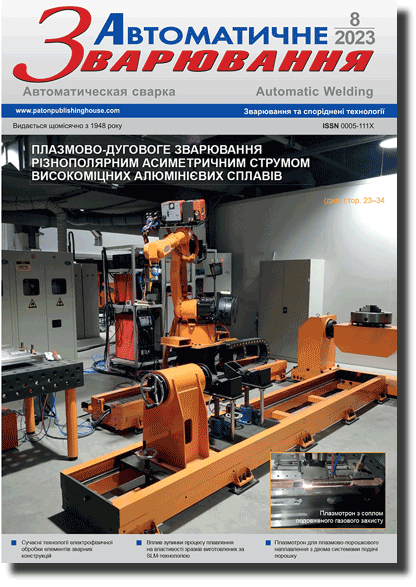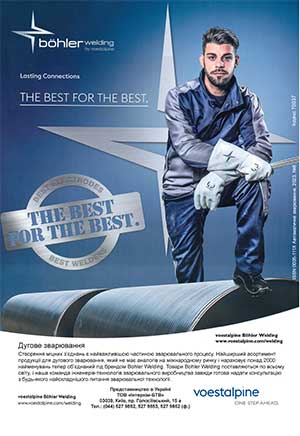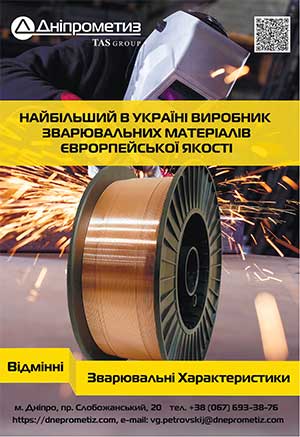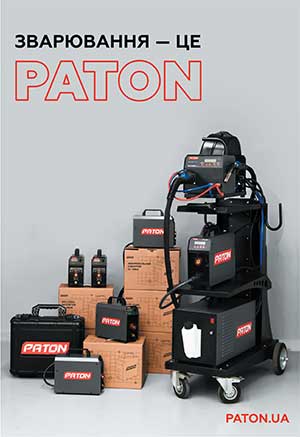| 2023 №08 (03) |
DOI of Article 10.37434/as2023.08.04 |
2023 №08 (05) |
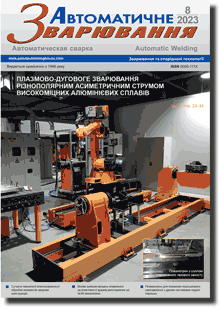
"Avtomatychne Zvaryuvannya" (Automatic Welding), #8, 2023, pp. 23-34
Influence of the speed of plasma-arc welding at a variable polarity asymmetrical current on the formation of joints of high-strength aluminium alloys
V.M. Korzhyk1, A.A. Grynyuk1, V.Yu. Khaskin1, E.V. Illyashenko1, S.I. Peleshenko2, A.O. Aloshyn2, I.O. Skachkov3, O.V. Dolyanivska3
1E.O. Paton Electric Welding Institute of the NAS of Ukraine. 11 Kazymyr Malevych Str., 03150, Kyiv, Ukraine. E-mail: office@paton.kiev.ua2LLC “Foreign Economic Representation of the E.O. Paton Chinese-Ukrainian Institute of Welding, 11 Kazymyr Malevych Str., 03150, Kyiv, Ukraine
3National Technical University of Ukraine “Igor Sikorsky Kyiv Polytechnic Institute”, 37 Peremohy Prosp., 03056, Kyiv, Ukraine
The effect of change in the speed of movement of the heating source in plasma-arc welding of aluminium alloys of 2.0 mm thick of three Al–Mg–Mn (AMg5M, AMg6), Al–Cu–Mn (1201) and Al–Cu–Li (1460) alloying systems on the microstructure and hardness of the weld metal and near-weld zone, on the formation of inner pores and mechanical properties of welded joints was considered. Changes in the distribution of temperature fields and indices of the stress-strain state of welded specimens were analyzed. It was found that for each type of alloys there is a certain “peak” welding speed, with exceeding of which there is no significant reduction in residual deformations and stresses, as well as a decrease in the width of the base metal heating zone. Instead, mechanical properties of welded joints are deteriorated because of an increase in the number of pores in the weld metal and the formation of inadmissible undercuts in the upper part of the weld in the area of transition from the weld to the base metal. On the example of Al–Mg–Mn alloy it is shown that such regularities are also typical not only for the thickness of 2.0 mm, but also observed during welding of specimens with the range of thicknesses of 4–8 mm. This allows using these results to predict indices of strength of the welded joint and weld metal for these thicknesses when the speed of plasma-arc welding at a variable polarity asymmetrical current is increased higher than the “peak” value. 15 Ref., 2 Tabl., 23 Fig.
Keywords: plasma-arc welding, variable polarity pulses, aluminium alloys, weld structure, pores, joint formation, strength, temperature distribution, stress-strain state
Received: 19.06.2023
References
1. Guan, R., Lou, H., Huang, H. et al. (2020) Development of Aluminum Alloy Materials: Current Status, Trend, and Prospects. Strategic Study of Chinese Academy of Engineering, 22, 5, 68-75. https://doi.org/10.15302/J-SSCAE-2020.05.0132. Samiuddin, M., Li, J.-L., Taimoor, M. et al. (2021) Investigation on the process parameters of TIG-welded aluminum alloy through mechanical and microstructural characterization. Defence Technology, 17, 4, 1234-1248. https://doi.org/10.1016/j.dt.2020.06.012
3. Lis, A., Mogami, H., Matsuda, T. et al. (2018) Hardening and softening effects in aluminium alloys during high-frequency linear friction welding. Journal of Materials Processing Technology, 255, 547-558. https://doi.org/10.1016/j.jmatprotec.2018.01.002
4. Xu, B., Chen, S., Jiang, F. et al. (2019) The influence mechanism of variable polarity plasma arc pressure on flat keyhole welding stability. Journal of Manufacturing Processes, 37, 519-528. https://doi.org/10.1016/j.jmapro.2018.12.026
5. Xu, B., Tashiro, S., Jiang, F. et al. (2019) Effect of Arc Pressure on the Digging Process in Variable Polarity Plasma Arc Welding of A5052P Aluminum Alloy. Materials, 12, 1071, 1-17. https://doi.org/10.3390/ma12071071
6. Lang, R., Han, Y., Bai, X., Hong, H. (2020) Prediction of the Weld Pool Stability by Material Flow Behavior of the Perforated Weld Pool. Materials, 13, 303, 1-20. https://doi.org/10.3390/ma13020303
7. Klett, J., Bongartz, B., Wolf, T. et al. (2023) Plasma welding of aluminum in an oxygen-free argon atmosphere. Advances in Materials Science, 23, 1(75), 5-18. https://doi.org/10.2478/adms-2023-0001
8. Labur, T.M., Grinyuk, A.A., Poklyatsky, A.G. (2006) Mechanical properties of plasma welded joints on aluminium-lithium aloys. The Paton Welding J., 6, 32-34.
9. Selva Bharathi, R., Siva Shanmugam, N., Murali Kannan, R., Arungalai Vendan, S. (2018) Studies on the Parametric Effects of Plasma Arc Welding of 2205 Duplex Stainless Steel. High Temperature Materials and Processes, 37, 3, 219-232. https://doi.org/10.1515/htmp-2016-0087
10. Sathishkumar, M., Manikandan, M., Subramani, P. et al. (2020) Effect of Welding Speed on Aspect Ratio of Hastelloy X Weldment by Keyhole Plasma Arc Welding (K-PAW). Materials Today, 22, 4, 3297-3304. https://doi.org/10.1016/j.matpr.2020.03.291
11. Batool, S., Khan, M., Jaffery, S. et al. (2015) Analysis of weld characteristics of micro-plasma arc welding and tungsten inert gas welding of thin stainless steel (304L) sheet. Proceedings of the Institution of Mechanical Engineers, Part L: Journal of Materials: Design and Applications, 230, 6. https://doi.org/10.1177/1464420715592438
12. Korzhyk, V., Khaskin, V., Grynyuk, A. et al. (2022) Comparison of the features of the formation of joints of aluminum alloy 7075 (Al-Zn-Mg-Cu) by laser, microplasma, and laser-microplasma welding. Eastern-European Journal of Enterprise Technologies, 1/12(115), 38-47. https://doi.org/10.15587/1729-4061.2022.253378
13. Grinyuk, A.A., Korzhyk, V.N., Babich, A.A. et al. (2016) Unified plasmatron for consumable electrode constricted arc welding. Tekhnologicheskie Sistemy, 4, 86-89 [in Russian]. https://doi.org/10.15407/tpwj2016.06.17
14. Lobanov, L.M., Pashchyn, M.O., Mikhodui, O.L. et al. (2021) Modeling of stress-strain states of AMg6 alloy due to impact action of electrode-indenter in electrodynamic treatment. The Paton Welding J., 6, 2-11. https://doi.org/10.37434/tpwj2021.06.01
15. (2018) Physical processes in welding and treatment of materials. Theoretical studies, mathematical modeling, computing experiment: Collect. of articles and reports. Ed. by I.V. Krivtsun. Kyiv, IAW [in Russian].
Advertising in this issue:
The cost of subscription/purchase order journals or individual articles
| Journal/Currency | Annual Set | 1 issue printed |
1 issue |
one article |
| TPWJ/USD | 384 $ | 32 $ | 26 $ | 13 $ |
| TPWJ/EUR | 348 € | 29 € | 24 € | 12 € |
| TPWJ/UAH | 7200 UAH | 600 UAH | 600 UAH | 280 UAH |
| AS/UAH | 1800 UAH | 300 UAH | 300 UAH | 150 UAH |
| AS/USD | 192 $ | 32 $ | 26 $ | 13 $ |
| AS/EUR | 180 € | 30 € | 25 € | 12 € |
| SEM/UAH | 1200 UAH | 300 UAH | 300 UAH | 150 UAH |
| SEM/USD | 128 $ | 32 $ | 26 $ | 13 $ |
| SEM/EUR | 120 € | 30 € | 25 € | 12 € |
| TDNK/UAH | 1200 UAH | 300 UAH | 300 UAH | 150 UAH |
| TDNK/USD | 128 $ | 32 $ | 26 $ | 13 $ |
| TDNK/EUR | 120 € | 30 € | 25 € | 15 € |
AS = «Automatic Welding» - 6 issues per year;
TPWJ = «PATON WELDING JOURNAL» - 12 issues per year;
SEM = «Electrometallurgy Today» - 4 issues per year;
TDNK = «Technical Diagnostics and Non-Destructive Testing» - 4 issues per year.





